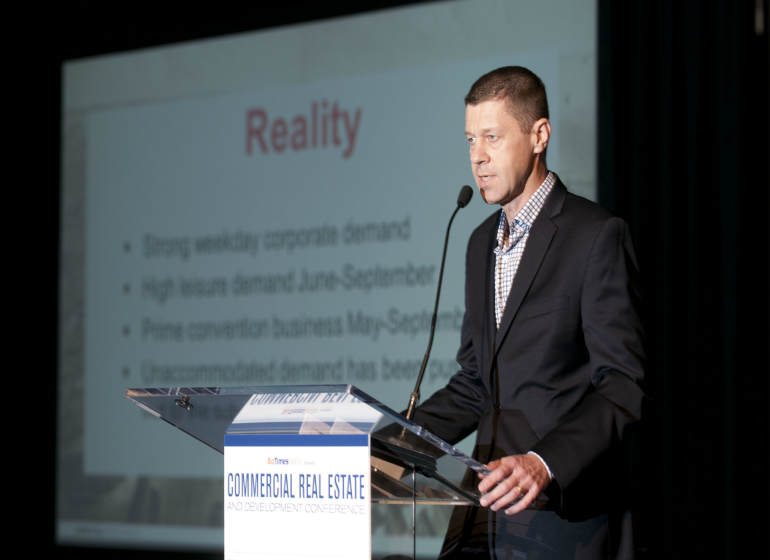Some of the leading executives in metro Milwaukee’s commercial real estate industry had some fun Thursday morning busting a few of the biggest myths in their industry during BizTimes Milwaukees’ annual Commercial Real Estate and Development Conference.
Addressing common assumptions including: the Milwaukee hotel market is overbuilt, the industrial market is stagnant due to outsourcing, and millennials are the driving force behind the booming apartment market, the panel set the record straight with their data and additional questions from the audience.
Dr. Mark Eppli, professor of finance and Robert B. Bell Sr. Chair in Real Estate at Marquette University moderated the event, held at Potawatomi Hotel & Casino, and also gave an economic outlook in the wake of Donald Trump’s election as president.
Bank stocks have risen at the possibility that the Consumer Financial Safety Bureau and possibly Dodd-Frank Wall Street reform will be will gutted, although much economic uncertainty still remains, Eppli said.
Each panelist was asked to bust one or more myths in their industry.
Doug Nysse, principal with Arrival Partners, who specializes in hotel projects and is currently involved in the downtown Westin Hotel project and is part of the team that has submitted the proposal to build Nexus at Fourth Street and Wisconsin Avenue, clearly does not believe the myth that Milwaukee is a terrible hotel market or the city is oversaturated with new hotels.
In reality, there is strong weekday corporate demand, high leisure demand in June through September and prime convention business in May through September, Nysse said.
“We are not overbuilt, we are under demolished,” he said.
James Barry III, president of The Barry Company, said that there has been a myth that the outsourcing of manufacturing overseas led to a decline in the industrial real estate market in the U.S. Quite the contrary, said Barry, whose company specializes on industrial real estate. Vacancy is at an all-time low, southeastern Wisconsin needs more inventory and the industrial real estate industry is definitely not in a decline, Barry said.
“Many people out there have an impression we have huge amounts of vacancy and obsolete plants sitting out there all over the place,” Barry said. “The truth is the industrial (real estate) stock is very strong and getting stronger.”
There have been many stories of employers moving their companies to downtown Milwaukee, but will that hurt the suburban office market? William Bonifas, executive vice president with CBRE doesn’t believe so.
“We have a large number of suburban firms that are growing in the suburbs and are committed to the suburbs, it’s a quieter story, but they don’t have any desire to move downtown,” Bonifas said. “Take for example Zywave. This is a millennial drive tech company and they are in the (Milwaukee County) Research Park (in Wauwatosa).”
Bruce Westling, principal NAI MLG commercial has specialized in retail real estate since 1990. He was asked if there was enough demand from area shoppers to support the numerous large, new retail developments in the Milwaukee area, from The Corners of Brookfield to the Mayfair Collection in Wauwatosa to 84South in Brookfield.
Westling said when a study was done on the future success and need for The Corners in 2011, it found the Milwaukee-area was 3 million square feet under-built for retail space.
“Mayfair (Mall in Wauwatosa) and Brookfield Square are as healthy as ever with occupancy rates over 95 percent and Bayshore (Town Center in Glendale) is continuing with its final phase of development,” Westling said. “And there have been no examples of any tenants poaching from existing centers.”
Despite the long-held belief that millennials are driving the downtown apartment housing market, Robert Monnat, chief operating officer at Mandel Group, Inc. busted that myth with data showing that since 2005, 50 percent of the apartments rented were from baby boomers while 11 percent were from millennials.
“We want to recreate more, we want to travel more. We haven’t had time to travel because we’ve been working our butts off,” Monnat said, referring to baby boomers. “It’s a lot easier to do all this stuff if you’re in the city and fortunately we can get out of our houses because housing prices have recovered.”
Speaker presentations can be viewed here.












